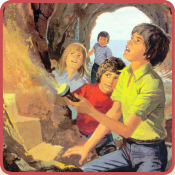
A Non Stop Run (No.207)

Book Details...
First edition: 1930
Publisher: Birn Brothers
Illustrator: Uncredited
Category: Birn Non-Series Story Books
Genre: Mixed
Type: Short Story Books
Publisher: Birn Brothers
Illustrator: Uncredited
Category: Birn Non-Series Story Books
Genre: Mixed
Type: Short Story Books
On This Page...
- A Non Stop Run
Story: Specially Written - The Signalman
Poem: Specially Written - The Turntable
Poem: Specially Written - The Look Out Man
Poem: Specially Written - The Wheel Tapper
Poem: Specially Written - Things I'd Like
Poem: Specially Written - The End
Poem: Specially Written

Front Cover

Back Cover

Title Page
Joan and Peter are going on a non-stop express steam train to visit their Grandma and Grand-dad. There is no mention on how old the children are or where they have to travel to, the only clue we have is that Peter says. "We're going on a non-stop run. That means the engine won't stop at all until we have got to Granny's station. It will go on and on through the night!"
At the station Mummy sees them safely onto the train after Joan has been allowed to buy the tickets. A porter puts their luggage into the luggage van and Mummy helps them to find a carriage. She then waves good bye and the children are alone.
How different from today. I very much doubt that any parent would want their children travelling without them. The children enjoy watching the scenery as they travel along, in their carriage. A porter is heard coming along the corridor passage ringing a bell, saying "Take your seats for dinner!" When he comes to Joan and Peter's carriage he stops, saying. "Come along. I've got a nice table for you two." They get up and follow him through three carriages until they come to the one in which dinner is being served.
You can almost imagine being back to the days of the steam train, the way Enid writes in such wonderful detail. The dinner served started with soup, then fish, then meat, and a 'lovely jammy pudding'. After that the waiter bought them fruit to choose from and a tray of coffee to pour out themselves. Joan says, "I do feel so grown up! Isn't it fun having a proper dinner like this in a train that's racing along all the time!"
There s a lovely little picture of the children sat at the table in the restaurant carriage, Peter looking smart with his shirt and tie and dark jacket, and Joan daintily holding onto her coffee cup, her little finger raised slightly.
After dinner they went back to their carriage until, a waiter came and took them to their sleeping cabin.
"Won't it be exciting to go to bed on the train whilst it's rushing along at fifty miles and more an hour." Said Joan.
That was one of the joys of steam travel. Yes, they were a lot slower than the trains of today, but they were much more comfortable I thought, with plenty of room to stretch out. The trains of today unfortunately like to pack in as many passengers as possible, without care of how much room they need!
Enid describes the lovely beds, just like at home with pillows, sheets and blankets, and in a rack above the beds were water-bottles and glasses. Also an electric fan above the door in case the bedroom became too hot.
The children wanted to s tay awake with excitement, but fell fast asleep, not hearing the train rumbling along or the whistling of the engine. As I read this memories of my own childhood came flooding back. I thought of the times when I woke during the night, and all was dark and quiet, and in the distance I could always hear the trains whistle, as they went rumbling along. It was always a comforting sound.
When Joan and Peter woke, they dressed and had breakfast. They looked out from the windows, at the houses and streets they were passing. With a long whistle the train ran into a great station, and drew up at an immense platform, but there is no mention of any names. Enid writes porters ran here and there with their barrows and there were lots of people waiting to welcome their friends. You can just imagine the busy scene as she writes it, and visualize a large station with many platforms and steam trains.
The children's Grandparents are there waiting for them, and a porter with his barrow gets their luggage. Grandpa asks the driver if the children could climb up and see inside his cab at the 'big fire'. Can you imagine any driver allowing that these days! Fire or no fire.
The rest of this little book, is full of lovely illustrations of railway scenes, a chapter titled , 'A Queer Railway', which Enid describes the railway of rack or cog in Switzerland. She writes about the signals on the railways, the signalman, and the wheel tappers.
There is a small section on, The Level Crossing, which takes you back to the days when all the crossings were manned with large closing gates. So different from today, when you get the inpatient driver who tries to dodge through the automatic half barrier in too much of a hurry to wait, not only endangering his own life, but the lives of the passengers on the oncoming train.
The date says this little book was first published in 1929, Enid's earlier works before many of the more famous titles she went on to write. Even this early in her writing career Enid tells the story with such enthusiasm I felt, and puts you right there in the year of the story, she's telling. You don't have to be an expert on steam trains or even know anything about them; Enid herself takes you on the steam journey, and describes everything you need to know to experience it20with Joan and Peter.
A book I feel is well worth reading, and owning to add to your collection.
The whole book from a scarce book that has never been reprinted.






































































